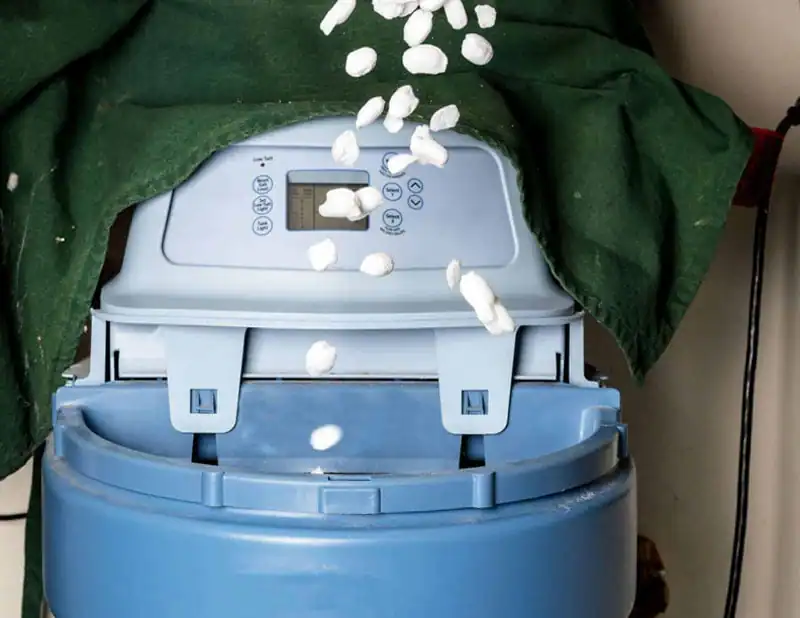Water softeners are an essential appliance in many homes, removing undesired minerals from the water. However, an issue that can occur in water softeners is the formation of a salt bridge. Salt bridges can significantly impact the performance of your water softener and reduce its ability to provide correctly softened water.
For this article, I wanted to dive into the topic of water-softener salt bridges and discover more about what they are, why they form, and how to prevent and fix them.
What Is a Water Softener Salt Bridge?
A water softener salt bridge is a buildup of salt that form a hard crust on top of the water softener’s brine tank. This crust can prevent the water softener from forming brine correctly and can lead to reduced efficiency of the system.
Salt bridges can occur when the salt in the brine tank clumps together to form a solid mass. This mass can form a cap or dome of salt with an air gap between the salt layer and the water that enters the brine tank to prepare for a regeneration cycle. As a result, the brine solution may not have the right salt concentration to effectively regenerate the resin, leading to reduced water softening performance. Sometimes it can be hard to see that this situation has formed because there may be fresh salt on top of the salt bridge.
By maintaining the proper salt level and using high-quality water softener salt, homeowners can prevent salt bridges from forming and ensure that their water softener operates effectively. But we’ll get into this more below.
What Causes a Salt Bridge To Form In a Water Softener?
In general, a major cause of water softener salt bridges is using low quality water softener salt, or salt types that are not recommended by the manufacturer of your system.
Salt pellets specifically designed for water softeners are often recommended by manufacturers, in part because the irregular pellet shapes tend to resist clumping. Some types of salt, such as rock salt are more likely to clump and also are of a lower purity, so are not recommended for use in a softener. For more about selecting a good quality salt for your system, please see A Guide To Water Softener Salt: Pellets, Blocks, Cubes, or Crystals. Mixing up two or more different types of salt can also contribute to clumping.
In addition to the type of salt being used, other factors that can contribute to salt bridge formation include:
- Temperature Changes
- High Humidity in the area around the Brine tank
- Infrequent Use of The Water Softener
To ensure that salt bridges are avoided in a water softener choose high-grade water softener salt and consistently use the system.
How Do You Recognize Salt Bridge?
As mentioned above, sometimes you really can’t tell that you’ve got a problem in the bottom of your brine tank because there is nice fresh salt on the top. A couple of signs that could clue you in:
- The system seems to be running normally, but your water is not as soft as it once was. Signs of this are needing more shampoo to get the same amount of lather as normal, or you see excessive spotting on glassware.
- The salt level in the brine tank doesn’t seem to be going down – or you are not having to add the normal amount of salt.
To check for a salt bridge:
- Try to remove an area of dry salt from the brine tank, to see if you can find an area that is clumping.
- Use a sturdy and blunt stick such as a broom or rake handle to poke down into the crust. Signs of a bridge are breaking out chunks of salt and the stick suddenly dropping into an open area below.
How to Remove a Salt Bridge
If you’ve determined that a salt bridge has formed, do this:
- Turn off the system.
- Remove as much dry and un-crusted salt as you can from the top of the brine tank. Any dry salt can be re-used later, so store it in a clean bucket or a sturdy box.
- Once you get to crusted salt, break it up with a sturdy & blunt stick such as a broom or rake handle. Discard any crusty chunks of salt – worry about the big pieces. If small amounts of salt falls down into the bottom of the tank it is okay for now.
- When the salt bridge is broken apart, it is best to clean the brine tank and follow the manufacturer’s instructions for setting up the brine tank similar to the initial installation. Some systems will want you to add water and some will do it when the regeneration cycle runs, so be sure to check the manual for your specific system.
- Refill the brine tank with clean, dry salt up to the fill line.
- Turn the system back on and monitor it through the next regeneration cycle.
How to Prevent a Salt Bridge in the Future
Here are some helpful steps you can take to prevent salt bridges from forming:
- Maintain the Proper Salt Level – Regularly add more salt as needed to ensure that the salt level stays within the recommended range. Each time you add salt, keep an eye out for signs of clumping. If the salt level did not go down the usual amount, you should investigate.
- Use High-Quality Water Softener Salt – High-quality water softener salt dissolves easily and reduces the risk of clumping. Avoid using rock salt or other non-recommended salt such as pool salt.
- Regularly Use the Water Softener – Regularly using the water softener can help to keep the brine solution free-flowing and prevent salt from clumping. When the water softener is not used regularly, the brine solution can become stagnant, allowing the salt to settle and clump together. If you are going on a long vacation and the system will not be used, check with your owner’s manual for the manufacturer’s suggestions on putting the system in vacation mode, if appropriate.
- Avoid Temperature Changes – Large temperature changes can cause the salt to expand and contract, leading to the formation of a salt bridge. To prevent temperature changes, keep the brine tank in a well-insulated area and avoid exposing the tank to direct sunlight.
- Maintain Low Humidity Levels – High humidity levels can cause the salt to absorb moisture and clump together. To prevent high humidity levels, use a dehumidifier in the area where the water softener is located.
Can A Salt Bridge Be Dissolved Without Breaking It Apart
In most cases, a salt bridge cannot be dissolved without breaking it apart.
If you happen to catch the clumping behavior early in the process, sometimes you can knock enough of the salt down into the bottom of the brine tank to return things to normal. Be sure to monitor your system carefully if this is happening. Review your situation (what salt am I using, humidity, system usage) to try to determine the most likely reason for clumping.
How Does a Salt Bridge Affect the Performance of a Water Softener
Salt bridges can result in:
- Reduced Water Softening Capacity – A salt bridge can keep the brine solution from having the right concentration of salt, reducing the water softener’s capacity to remove hard water minerals. This can result in hard water being dispensed into your home, leaving mineral buildup on fixtures and appliances and reducing the effectiveness of soaps and detergents.
- Inefficient Regeneration Cycles – A salt bridge can cause the brine solution to become stagnant, resulting in the regeneration cycle not running properly.
- Reduced Lifespan of The Water Softener – A salt bridge can cause the brine solution to become contaminated, leading to corrosion and other damage to the water softener. Over time, this can reduce the lifespan of the system, increasing the need for repairs and replacement parts.
To ensure optimal performance, it is important to regularly monitor the brine tank and prevent salt bridges from forming.
How Often Should I Check My Water Softener
It’s a good idea to check your water softener system once a month.
For more on simple maintenance of your system, including keeping an eye out for salt bridges and normal consumption of salt, please see our article Essentials of Water Softener Maintenance.
Final Thoughts
In addition to checking monthly for appropriate operation and to fill the brine tank up to the proscribed level, it is also a good idea to keep an eye on your water softener during periods of heavy use. For example, during seasons when you may be using more water for cleaning or frequent showers, it’s a good idea to keep an eye on the water softener so that it can operate at peak performance.
Also, if you haven’t used your water softener in a while, make sure to check for a salt bridge before turning it back on. This will help ensure your system is functioning properly and you are getting the best possible water quality.







